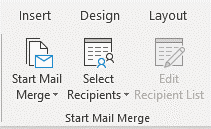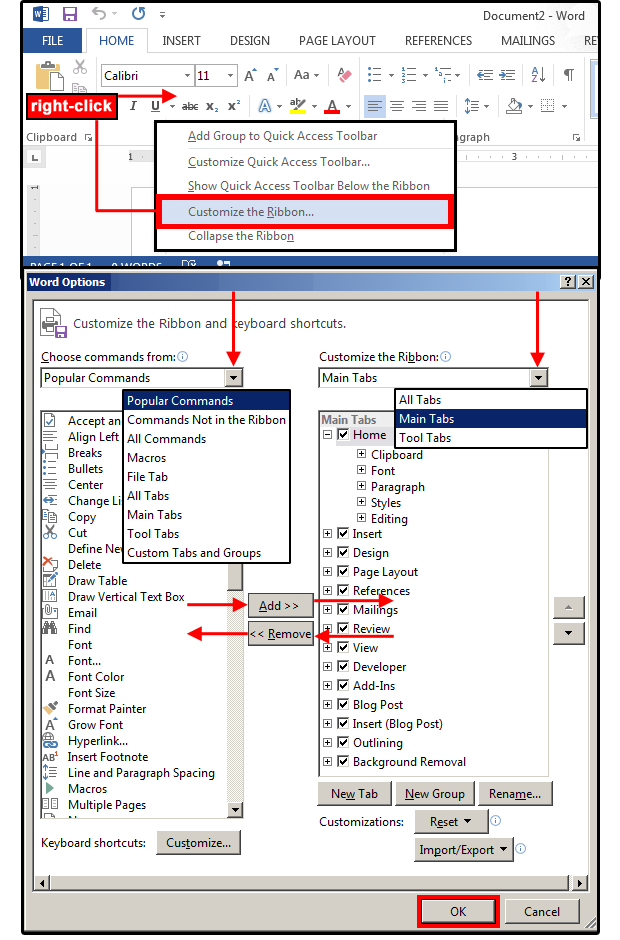

To add commands to your new tab, left-click the appropriate command from the menu on the left and drag it into your new tab.Right-click the New Tab and New Group options to change the name, location, or other options related to your selection. The New Tab (Custom) option will have a “New Group (Custom) option as a sub item.Underneath the right column, click the New Tab option to add a tab option to your Tabs list.There’s no need to click through each tab trying to remember where that important tool resides. You can use a custom tab to keep all of your favorite actions in one place. When you create a custom tab, you choose which commands to include. When applied, the Developer tab appears to the right of (or after) the View tab. Here, the “Developer” option is listed below (or after) the View tab option. The order of the options indicates the order in which the new tab will appear on the ribbon.

A popular tab to add to the ribbon is the Developer tab. From the options panel, check the tabs you want to be included on your ribbon and uncheck tabs you do not want.“Tool tabs” are context-sensitive tabs that show only when you are using specific options (for instance, the Table Tools tab only displays when you are working with tables). Select an option from the “Customize the Ribbon” drop-down menu to designate which tab to customize.“Main tabs” show by default.The right column allows you to customize the Office 2013 ribbon. This primary part of the window has several customization options available.įrom this window, you are able to add, remove, and create new tabs. Select Customize the Ribbon in the drop-down menu.Regardless of which tab is selected, navigate your mouse to the ribbon and right-click (Alternatively, you can also click the File tab and choose Options).First, let’s access the “Customize the Ribbon” options window.
Remove the mailings tab from the ribbon how to#
In this tutorial, we’ll cover How to Add or Remove an Existing Tab, and How to Create a Custom Tab. The example below refers to Microsoft Word, but this feature is available in other Microsoft Office programs and subsequent versions. It’s relatively simple to customize the Office 2013 Ribbon, adding, removing, and even creating unique tabs for the ribbon.

In either case, ribbon customization allows users to make the ribbon work for their particular needs and workflow. Some users found it convenient and easier to navigate while others found it cumbersome and confusing. Subscribe to get more articles like this oneĭid you find this article helpful? If you would like to receive new articles, join our email list.When Microsoft introduced the ribbon in 2007, there were mixed reviews. The name of the number merge field in the above examples comes from the Excel source file. In the examples above, commas would be inserted only if the number was one thousand or more. This suppresses zeros from empty fields and from fields containing zeros. Zero values can be suppressed by adding a final semicolon ( ) in the switch but nothing after it.
Remove the mailings tab from the ribbon full#
The syntax of the full mail merge number field code with the switch is: The merge codes may appear in quotes or double quotes. Number switches start with \# and the codes that follow represent the format for the number. Since # specifies the minimum numeric places to display, if a place has no digit, it is replaced with a space. You can also enter commas (,), decimals (.) and currency signs ($). The # code will be replaced by a digit only if it is not a leading or trailing zero. Codes entered in switches can contain multiple parts separated by semi-colons: The common codes used in a number switch are 0 for a required digit and # for a variable number. Related article: How to Use Mail Merge in Microsoft Word to Generate Form Lettersĭo you want to learn more about Microsoft Word? Check out our virtual classroom or live classroom Word courses > Using codes in a number field switch You can use switches to change the format of a number field to display currency symbols as well as commas or decimals.Ī number field is typically inserted in the main document using Insert Merge Field on the Mailings tab in the Ribbon. Number formatting issues typically occur when the source document for the mail merge is an Excel workbook or Access database.

You can change or fix the format of a number field in a Word mail merge document using switches in field codes. Change the Format of a Number Field in a Microsoft Word Mail Merge Document Using Switchesīy Avantix Learning Team | Updated January 16, 2021Īpplies to: Microsoft ® Word ® 2010, 2013, 2016, 2019 and 365 (Windows)


 0 kommentar(er)
0 kommentar(er)
